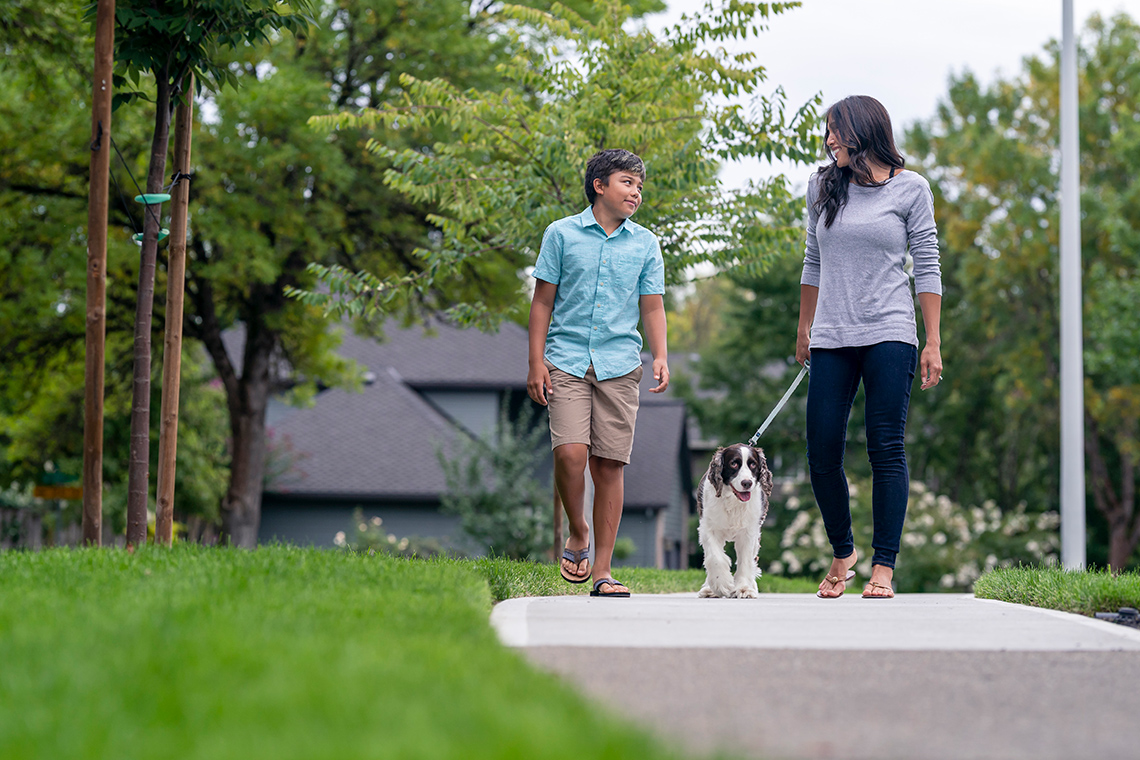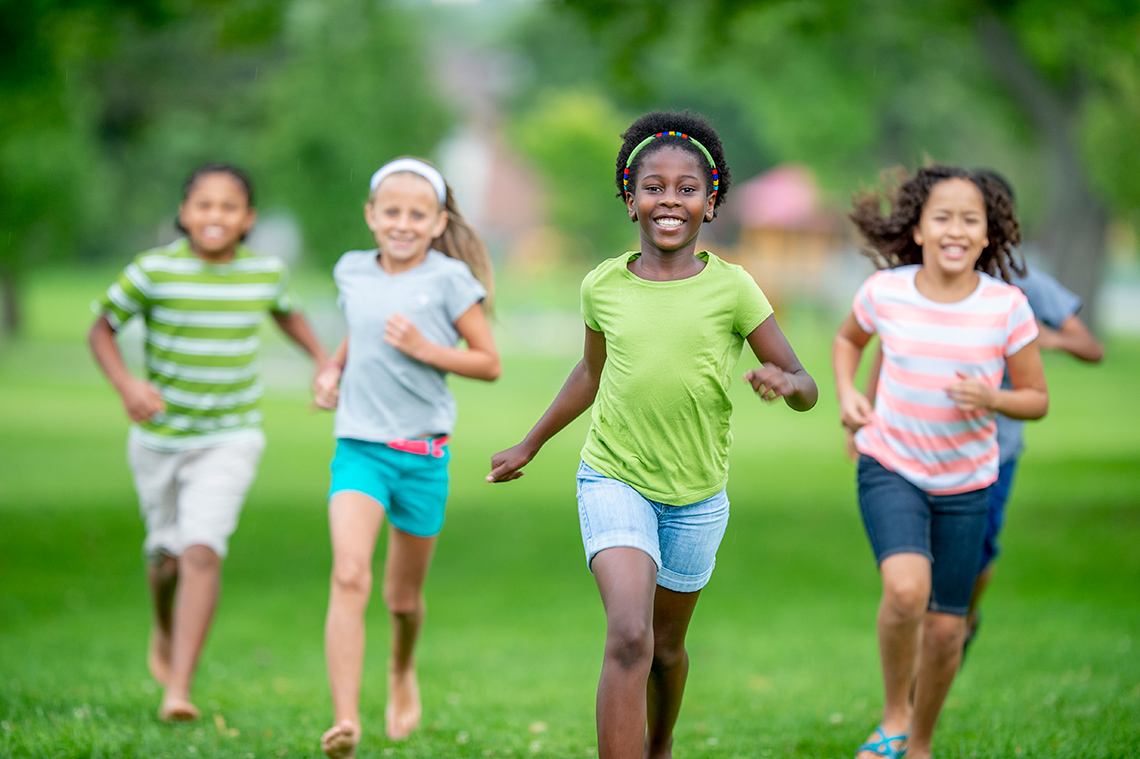Minds On
Locomotion

Locomotor movements are actions that move the body from one location to another. These movements are used throughout the day and form the basis of many movements in sports!
Consider and reflect on the following questions:
- What locomotor movements do people use the most in everyday life?
- What movements do we use less as we get older? Why?
- How are sports movements different from everyday locomotor movements?

Walking from one place to another is a type of locomotor movement.
Brainstorm
Types of locomotion
What are some different ways people can move their bodies from place to place?
Come up with as many unusual ideas as you can. Record you answers using a method of your choice.
Action
Locomotion

There are many locomotor skills that help us move from place to place. However, most days we only use one or two ways. For example, we walk or run. We often use all the other ways to move or recognize how the movements are part of the sports and activities we play. As you move through this lesson, you’ll explore many ways to move your body through space.
Safety
Before you begin, consider these safety precautions:
Warm Up
Warm up
Your body needs to be warmed up before you exercise. You can do this by completing the following stretches and light aerobic exercises, which will help you better perform a movement/activity while also greatly reducing your chance of injury.
Always warm up before doing any physical activity!
Press the following tabs to explore and try different warm up activities.

If you can, let’s stretch our necks! This stretch can be performed standing up or in a seated position. Keep your shoulders relaxed as you begin with your head facing forwards. Gently and slowly tilt your head to the right. Hold here for five seconds. Begin rolling your head slowly, keeping your chin tucked and head down, to the opposite side. Hold for five seconds. Roll your neck back to the middle, then bring your head up to the starting position. Repeat 3-5 times.

If you can, let’s warm up our shoulders! Either standing or in a seated position, raise and extend your arms to the sides without bending the elbows. If you are standing, have your feet shoulder-width apart. Keep your thumbs pointing in front of you. Begin slowly rotating your arms forward, making small circles. Go forward for 20-30 seconds, then backwards for the same amount of time.

If possible, stand tall and shift your weight to your right leg. Lift your left foot back and hold it with your left hand. Pull the left foot towards your butt and feel the stretch. Hold the stretch for 20 seconds and repeat with the right leg. Repeat the stretch five times for each leg.

Stand or sit upright with your hands to your sides and lift one leg slightly up to make small circles with your ankles. Do this 10 times in each direction and repeat with your other foot.

Stand or sit upright with your hands in front of your chest. Hold one wrist with the other hand and make small circles with the wrist that is being held. Complete this 10 times in each direction and repeat with your other hand.

Begin in a standing position with your legs together and your arms at your sides. Stretch your arms above your head and jump slightly so that your feet are spread wider than shoulder-length. Repeat this movement ten times.
Powering up
Let’s explore the following video entitled “Power Up: Under the Sea 5” to warm up and to learn more about different locomotor movements. Do your best to follow along with the various movements demonstrated in the video.
Reflection
Now that you have completed the warm up, answer the following questions.
- What did you notice about the movements in this video?
- Which movement did you find easiest? Hardest?
Locomotor movements
There are several locomotor movements that successfully transfer our weight from one location to another.
How we move
Some examples of locomotor movements may include:
- walking/striding
- marching
- jumping
- hopping
- galloping
- sliding
- skipping
Explore the following images and instructions to help you perform each movement. When you are ready, try to do the movement for up to 30 seconds. That’s over three minutes of activity. Can you do them one after the other?
Press the following tabs to access ways to complete each locomotor movement.
To jump, begin by bending your knees and hips. Keep your feet close together. Keep your arms straight and by your side. As you begin to jump, press your feet into the ground and take off with both feet at the same time. As you do this, thrust your arms up. As you land, make sure you land on the balls of your feet.
Check out the following video to learn more about how to jump.
Bring one knee up high and then take a step forward. As you do, bring your arm on the opposite side forward and the other back. Now, bring the other knee up high and step forward again. Repeat what you did with your arms. Continue this motion.
Access the following video to learn more about how to march.
Begin with your feet close together. Choose your left or right leg as your hopping foot. This is the foot that will hit the ground. Lift the opposite foot up so that your knee is bent to 90 degrees. With this leg up, swing your arms and jump up. Try to land on the ball of your foot
Explore the following video to learn more about how to hop.
Skipping is like hopping except you move forward when you jump. Then, rather than jumping up and down on the same leg, you repeat the hop with the opposite leg. Remember to jump just a little bit up and a little bit forward. The motion should be smooth from one leg to the other.
Access the following video to learn more about skipping.
Face forward with your legs together. Lift your right foot and take a step to the side. After stepping with this foot, bring the other foot beside it. Continue this motion in the opposite direction and repeat.
You may also complete this movement by striding diagonally to the right, then move the left foot beside the right. Move your left leg then your right leg back to where you started, Repeat moving to the left.
Check out the following video to learn more about how to slide.
Take a step forward on one foot. As this foot is firmly on the ground, follow it with a step forward on the other foot. Keep moving forward using this motion. Be sure to move your arms with the motion to help keep your balance.
Striding can be accomplished by performing any movement which allows a person to move smoothly through an area.
Explore the following video to learn more about striding.
Let’s loco-motor

For this activity, you’ll create a routine like the one you explored in the previous video.
Remember to perform your safety check before you begin.
For this activity, have the following prepared:
- a clear, open space
- a chair to sit on if needed
Starting the locomotor activity
Locomotor activities help condition our bodies. They make us stronger and keep us fit. These movements can be put together into a form of workout.
In this activity, you’ll create a short “workout” routine. You can choose your movements based on a sport or activity, or just put some movements together.
Locomotor activity checklist
Make sure your routine includes:
Each action should last for least 20 seconds before switching to another movement.
Complete the My Locomotor Routine Chart in your notebook or using the following fillable and printable document. You can outline the various locomotor moves, any changes in direction or balance moves, and how long each move takes to do.
If you would like, you can use speech-to-text or audio recording tools to record your thoughts.
Press ’Modifications’ to access two other options to consider when organizing your locomotor routine.
If you play a sport, create a routine with movements that are part of the sport. Think about how the movement routine will help someone get fit and get better at their sport.
You can also create a video much like the “Power Up: Under the Sea 5” video from the previous section — complete with instructions and motivation to encourage participants!
| Music/song of choice: | |
|
Four locomotor movements: 1. 2. 3. 4. |
How long it takes to complete each move: 1. 2. 3. 4. |
|
Two changes in direction: 1. 2. |
How long it takes to complete each move: 1. 2. |
|
Two balance moves (optional): 1. 2. |
How long it takes to complete each move: 1. 2. |
Press the ‘Activity’ button to access My Locomotor Routine Chart.
Cool Down
Loco-slow
Remember to perform your safety check before you begin!
- Choose a locomotion of your choice (walk, jog, shuffle, skip, and etc.).
- Move around slowly around the room or your space while doing any of the
following:
- touch shoulders with hands, then reach up over your head 10 times
- wave arms from side to side and forward like a tree 10 times
- raise knees slightly, then take 10 giant steps in slow motion
Consolidation
Making your own game

While exercise routines (and videos!) are a good way to improve our fitness, games are another way where the players don’t even know they are exercising.
In this activity, you’ll create a game of “Red Light, Green Light” using a variety of locomotor movements you learned about and practised in the previous section. Don’t worry: this is just a friendly game!

Setting up your game
In your game, there will be two rounds. Each round will need to have unique locomotor movements in them. For example, only round 1 or round 2 can have the hop movement.
You will choose a locomotor movement for the player to complete for the green, red, and yellow lights. You goal is to try and make round 2 harder than round 1!
Complete the Red Light, Green Light Game in your notebook or using the following fillable and printable document. If you would like, you can use speech-to-text or audio recording tools to record your thoughts.
| Round 1 | |||
| Light | Green Light | Red Light | Yellow Light |
| Movement | |||
| Round 2 | |||
| Light | Green Light | Red Light | Yellow Light |
| Movement | |||
Press the ‘Activity’ button to access Red Light, Green Light Game.
If possible, have a peer, sibling, or parent/guardian test out your game with you. You can also try the game by yourself!
Pause and Reflect
Pause and reflect
After you have completed the game of “Red Light, Green Light,” answer the following questions.
- What was your strategy with round one?
- What was your strategy for making round two harder?
Thinking about locomotor movements
- Which locomotor movement did you prefer the most?
- Which locomotor movement did you prefer the least?
- Which locomotor movement was the most challenging for you?
- Name a physical activity that you believe uses the most forms of locomotor movement and explain why.
Reflection
As you read through these descriptions, which sentence best describes how you are feeling about your understanding of this learning activity? Press the button that is beside this sentence.
I feel…
Now, record your ideas using a voice recorder, speech-to-text, or writing tool.